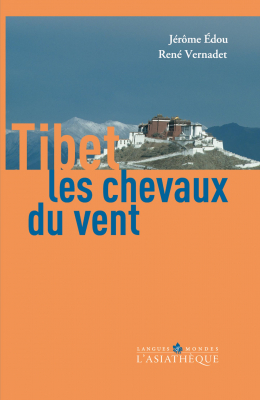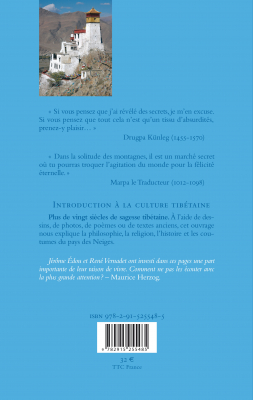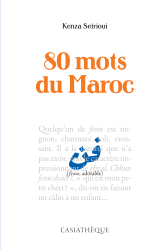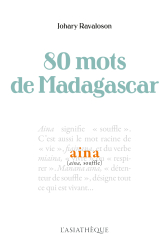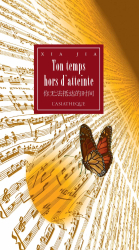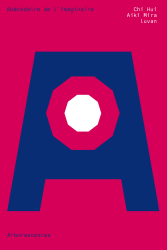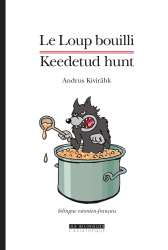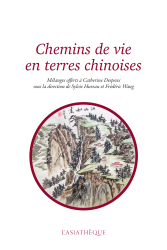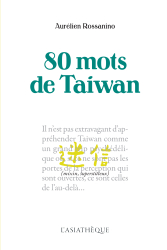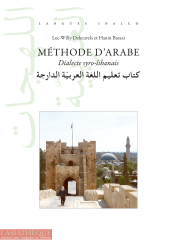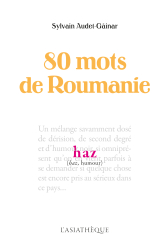Details
Format: Paperback
ISBN: 9782915255485
Collection: Hors Collection
13.5 x 21.5 cm
Weight: 597 gr
Pages: 496
Edition :
2007
First publication: 27/01/1993
Last printing: 04/2007
CLIL: 4093
BISAC: SOC008020
Tibet, les chevaux du vent
Une introduction à la culture tibétaine
New edition of the book by the same authors, already published by L'Asiathèque. The work has been reviewed, updated and considerably expanded. The bibliography has been supplemented and updated, as have the photos. This book traces the history of Tibet to the present day, and pays close attention to the cultural and religious aspects of Tibetan traditions. Intended also for the traveler, it details itineraries and describes the main sites to visit. Jérôme Edou has lived in Nepal for many years, and runs a travel agency which primarily organizes treks. (Base Camp Trek) René Vernadet is a mountain climber and lecturer at Connaissance du Monde, who has retired to Chamonix but remains active in the mountain climbing world.
PRESS REVIEW
Extract from the report of the Venerable Shinjin
"... In this complete, pleasant and detailed book, with a lively, alert, even warm style, punctuated with anecdotes, historical accounts, instructive explanations on specific points, readers will discover all the elements that make Tibet an attractive country, even bewitching since the people who have already been there have not come back to the same ... "
Tibet, les Chevaux du Vent
"... A" revised and enhanced "reissue of a great classic that continues to open many keys to Tibet. Jérôme Edou and René Vernardet offer here an accessible and sensitive amount: texts, drawings, photos, poems and ancient texts make up an involved and scholarly ode to the country under the sky ... "
CONTRIBUTORS' BIOGRAPHIES
René Vernadet
René Vernadet (born in 1927) is a filmmaker and director and a mountain writer. Passionate about Tibet since 1962 and lecturer at Connaissance du Monde, he retired to Chamonix, but remains active in the networks of mountaineering enthusiasts.
Jerôme Edou
Jérôme Edou was born in Paris in 1952. After studying sociology, he discovered Buddhism in India and Nepal in the 1970s and has since resided in the latter country. A great traveler, Tibetologist and writer, he published "Tibet, the horses of the wind" at the Asiatheque, an authoritative introduction to Tibetan culture. He writes for the "Trek Magazine" and directs Base Camp Trek, a French-speaking travel agency based in Kathmandu, which organizes trekking in particular.
TABLE OF CONTENTS
En guise de préface (As a preface)
Carte générale du Tibet (General map of Tibet)
Introduction (Introduction)
Première partie : De l’histoire (Part 1 : Of History)
I. Du mythe à l’histoire (I. From myth to history)
1. Les fils de la démone (1. The sons of the demoness)
La mer de Téthys et le plateau tibétain (1) (The Tethys Sea and Tibetan Plateau (1))
2. Le secret (2. The secret)
3. Pour l’amour d’une princesse (3. For the love of a princess)
4. Padmasambhava (4. Padmasambhava)
5. Le débat de Samyé (5. The Samyé debate)
Le débat (2) (The debate (2))
II. Des lamas et des khans (II. Lamas and Khans)
1. La seconde diffusion du bouddhisme (1. The second diffusion of Buddhism)
2. L’apogée des Sakyas (2. The apogee of the Sakyas)
3. Quand l’océan de sang (3. When the ocean of blood)
Dalaï Lamas et Panchen Lamas (3) (Dalai Lamas and Panchen Lamas (3))
4. Le Grand Cinquième (4. The Big Fifth)
III. L’influence mandchoue (III. The Manchu influence)
1. Lama et poète (1. Lama and poet)
2. La présence mandchoue (2. The Manchu presence)
3. La route du sel et les gourkhas (3. The salt road and the gourkhas)
4. Comme des plumes au vent (4. Like feathers in the wind)
Guendün Chöpel (4) (Guendün Chöpel (4))
5. 1914-1950 : vers l’indépendance ? (5. 1914-1950: towards independence?)
IV. Quatre fleuves, six montagnes (IV. Four rivers, six mountains)
1. L’invasion chinoise (1. The Chinese invasion)
2. La révolte de Lhassa (2. The Lhasa revolt)
Le Dalaï Lama et la révolte (5) (The Dalai Lama and the revolt (5))
3. Génocide au Tibet ? (3. Genocide in Tibet ?)
Extraits du rapport de la Commission d’enquête sur la question du Tibet (6) (Excerpts from the report of the Commission of Inquiry on the Question of Tibet (6))
4. La Révolution culturelle (1966-1972) (4. The Cultural Revolution (1966-1972))
Ani Panchen, nonne et combattante (7) (Ani Panchen, nun and fighter (7))
V. Tours et détours de l’histoire (V. Twists and turns of history)
1. L’espoir (1. The hope)
2. Le Tibet sinisé (2. Sinicized Tibet)
3. Démocratie en exil (3. Democracy in exile)
Tim, Colin, Ken et les autres… (8) (Tim, Colin, Ken and the others... (8))
4. La fin de l’histoire ? (4. The end of the story?)
Deuxième partie : Du bouddhisme tibétain (Part Two: Tibetan Buddhism)
I. De la philosophie aux tantras (I. From philosophy to the tantras)
1. Si tu croises le Bouddha dans la rue (1. If you meet the Buddha in the street)
2. Philosophie ou religion ? (2. Philosophy or religion ?)
3. À la recherche du soi (3. In search of the self)
4. L’illusion du moi (4. The illusion of the self)
5. Le vide et la forme (5. The void and the shape)
Le mythe de Shambhala (9) (The myth of Shambhala (9))
6. La transmutation des apparences (6. The transmutation of appearances)
II. Le bouddhisme du Tibet (II. The Buddhism of Tibet)
1. L’organisation monastique (1. The monastic organization)
2. Autorité spirituelle et pouvoir temporel (2. Spiritual authority and temporal power)
3. La tradition érémitique (3. The eremitic tradition)
4. Milarépa (4. Milarepa)
5. Les écoles bouddhiques du Tibet (5. The Buddhist schools of Tibet)
Les chevaux du vent (10) (The horses of the wind (10))
6. La tradition bön (6. The Bön tradition)
III. L’univers du divin (III. The universe of the divine)
1. Rituels et divinités (1. Rituals and deities)
2. Lamas et protecteurs (2. Lamas and protectors)
3. Oracles et devins (3. Oracles and fortune-tellers)
Faiseur de pluie (et de beau temps) (11) (Rainmaker (and fair weather) (11))
4. Mort et réincarnation (4. Death and reincarnation)
La réincarnation du XVIe Karmapa (12) (The reincarnation of the 16th Karmapa (12))
5. La légende du grand stoupa (5. The legend of the great stupa)
Troisième partie : Du Tibet (Part 3: Of Tibet)
I. Vivre au Tibet (I. Living in Tibet)
1. Aristocrates et paysans (1. Aristocrats and peasants)
2. Nomades (2. Nomads)
Cimetières célestes (13) (Celestials cemeteries (13))
3. Caravanes (3. Caravans)
4. Pèlerinage à la montagne sacrée (4. Pilgrimage to the sacred mountain)
5. Les explorateurs (5. The explorers)
Regard sur la médecine tibétaine (14) (A look at Tibetan medicine (14))
II. L’art et la fête (II. Art and celebration)
1. L’art sacré (The holy art)
2. L’opéra et le chant (2. The Opera and the singing)
Les chants de rue de Lhassa (15) (The street songs of Lhasa (15))
3. Nouvel an à Lhassa (3. New Year in Lhasa)
La langue tibétaine (16) (The Tibetan language (16))
4. Le masque des dieux (4. The mask of the gods)
Quatrième partie : Des sites principaux (Part 4: Main sites)
Table des principaux sites (Table of main sites)
Carte du Kham et de l’Amdo (Map of Kham and Amdo)
I. Le Kham (I. The Kham)
1. De Chengdu à Chamdo (From Chengdu to Chamdo)
2. La route du sud, de Kanzé à Lijiang (2. The southern road, from Kanzé to Lijiang)
3. La route du nord, de Dergué à Jékundo (3. The northern road, from Dergué to Jékundo)
II. L’Amdo (II. Amdo)
1. Le nord (1. The north)
2. La boucle du fleuve Jaune (2. The Yellow River Loop)
Moi le Ngolog (17) (I, the Ngolog (17))
3. Le sud de l’Amdo (3. The south of Amdo)
Carte du Tibet central (Map of Central Tibet)
III. Le Tibet central (III. Central Tibet)
1. De la frontière népalaise à Shigatsé (1. From the Nepalese frontier to Shigatsé)
La statue de Langkhor (18) (The statue of Langkhor (18))
2. De Shigatsé à Lhassa (2. From Shigatsé to Lhasa)
3. La vallée du Tsangpo (3. Tsangpo valley)
* La Dame des Neiges immaculées (19) (*The Lady of the Immaculate Snows (19))
4. Le Lhodrak (Tibet du Sud) (4. The Lhodrak (South Tibet))
IV. Lhassa (IV. Lhasa)
1. La ville (1. The city)
* È pericoloso… (20) (* È pericoloso… (20))
2. Les Universités monastiques (2. The monastic Universities)
3. Autour de Lhassa (3. Around Lhasa)
* Carte du Tibet de l’Ouest (* Map of West Tibet)
V. Le Tibet de l’Ouest (Ngari) (V. West Tibet (Ngari))
Annexes (Appendices)
Notes (Notes)
Petite chronologie historique (Short historical chronology)
Quelques repères iconographiques (Some iconographic references)
Calendrier et fêtes principales (Calendar and major holidays)
Glossaire (Glossary)
Index (Index)
Bibliographie (Bibliography)
Deux cahiers hors texte de seize pages chacun comprenant quarante-neuf photographies (après les pages 128 et 384). (Two hors texte booklets of sixteen pages each including forty-nine photographs (after pages 128 and 384).)
